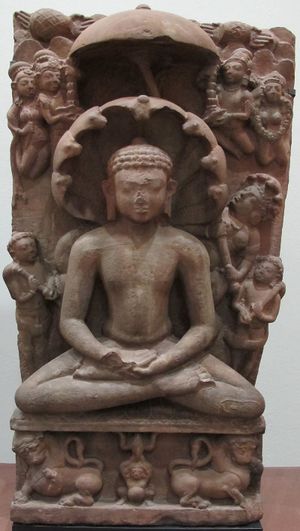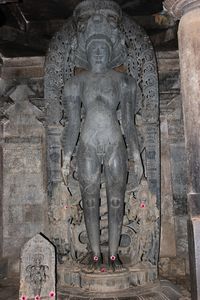پارشڤاناثا Parshvanatha
| بارشفاناثا | |
|---|---|
23rd Jain Tirthankara | |
 صورة الترثانكارا پارشڤاناثا (متحف ڤكتوريا وألبرت، القرن السادس أو السابع) | |
| السابق | نميناتا |
| التالي | مهاڤيرا |
| الرمز | ثعبان |
| القامة | 9 cubits (13.5 feet) [1] |
| العمر | 100 years[2] |
| الشجرة | Ashok |
| اللون | أخضر |
| معلومات شخصية | |
| وُلِد | ح. 872 ق.م.[3] |
| توفي | ح. 772 ق.م.[3] |
| الأبوان |
|
| الزوج | پراباڤاتي[4] |
| الأسرة | Ikshvaku dynasty |
پارشڤاناثا (Pārśvanātha؛ إنگليزية: Parshvanatha)، ويُعرف أيضاً بإسم پارشڤا (Pārśva)، كان الترثانكارا الثالث والعشرين في الجاينية.[5][6] وهو أقدم زعيم جايني (ح. 872) يوجد دليل معقول على تواجده التاريخي.[7][8]
التاريخانية
الدليل الظرفي على وجوده يضم وصف لتعاليم پارشڤاناثا في أقاويل العرافين، يملي علينا أن پارشڤاناثا يمكن اعتباره شخصية تاريخية (وليست أسطورية).[9][2][10][11][12][13][14]
سيرته
وُلِد پارشڤاناثا في اليوم العاشر من النصف المظلم من شهر Paush to King Asvasena and Queen Vamadevi of Benaras (now Varanasi).[15][9][16] He belonged to the Ikshvaku dynasty.[17][18] He assumed and began to practice the twelve basic vows of the adult Jain householder when he reached the age of eight.[19]
Parshvanatha lived as formal prince of Varanasi and at the age of thirty, he renounced the world to become a monk.[20] He meditated for eighty-four days before attaining Kevala Jnana.[21] وقد حقق الموكشا في عمر المائة فوق Shikharji,[9][16] which is known today as the Parasnath Hills after him. Parshvanatha was called purisādāṇīya (beloved of men), a name which shows that he must have been a genial personality.[17] He remains beloved among Jains.[22]
ميلاداته السابقة
- Marubhuti - Visvabhuti, the prime minister of King Aravinda had two sons, elder one named Kamath and younger one named Marubhuti (Parshvanatha). Kamath killed Marubhuti and died as a criminal.[23]
- Elephant - He was then reborn as an elephant in the forests of Vindyachal. His name was Vajraghosha (Thundering Voice of Lightening). Meanwhile, King Aravinda, after death of his minister Marubhuti, renounced his throne and was leading an ascetic life. When the elephant came near Aravinda, he recalled his previous human life by the blessings of Aravinda and became calm. Kamath was reborn as a serpent this time.[24] One day, when the elephant went to a river to quench his thirst, the serpent attacked him and he died the peaceful death of absolute renunciation.[25]
- Sasi-prabha - Vajraghosha was reborn as Sasi-prabha (splendor of the moon) in the twelfth heaven and the serpent went to hell.[25]
- Agnivega - After spending a luxurious life in heaven, he was reborn as prince Agnivega (strength of fire). He ascended the throne of his father which he later renounced to lead an ascetic life. Kamath was reborn as a serpent again after hell and again killed the ascetic in Himalayas during penance.[26]
- When he was a prince he saved two snakes that had been trapped in a log in an Kamath’s fire. Later, the snakes were reborn as Dharnendra, the lord of the underworld kingdom of the nāgas, and Padmavati. Dharnendra and Padmavati sheltered Parshvanatha from a storm sent by a Meghmali (Kamath reborn).[27]
تعاليمه

According to the Kalpa Sūtra, Parshvanatha had 164,000 śrāvakas (male lay followers) and 327,000 śrāvikās (female lay followers) and 16,000 sādhus (monks) and 38,000 sādhvīs (nuns). He had eight ganadharas (chief monks): Śubhadatta, Āryaghoṣa, Vasiṣṭha, Brahmacāri, Soma, Śrīdhara, Vīrabhadra and Yaśas. After his death, the ganadhara Śubhadatta became the head of the monastic order. He was then succeeded by Haridatta, Āryasamudra and Keśī.[20]
Śvētāmbara texts explain that a sage named, Keśī was born about 166 to 250 years after the death of Parshvanatha met the Indrabhuti Gautama, the chief disciple of Mahavira and asked him twelve questions.[28] One of the question as mentioned in Śvētāmbara text was "The Law taught by the great sage Parsva, recognises but four vows, whilst that of Vardhamana enjoins five". Therefore, according to Śvētāmbara texts, Parshvanatha taught four vows instead of the presently famous five vows (mahavratas).[29] This view is however not accepted by the Digambaras. On this, Champat Rai Jain in his essay titled "The Origin of The Swetambara Sect" wrote:
The first question Kesi put to Gautam was why did Mahavira insist upon the observance of five vows when Parashvanath did not mention five but only four, excluding celibacy? But the question would have had a point if it could be shown that salvation could be obtained without the observance of celibacy. So far as I understand Swetambara books themselves insist upon an observance of this vow, and it is not possible that two omniscient teachers, i. e., Parashvanath and Mahavira could teach different things.
في الأدب
Acharya Jinasena's Mahapurāṇa include Ādi purāṇa and Uttara-purāṇa. It was completed by Acharya Gunabhadra, the disciple of Jinasena in the 8th century C.E. In Ādi purāṇa, life events of Rishabhanatha, Bahubali and Bharata are detailed out.[31]
Kalpa Sūtra is biographies of the Jain Tirthankaras, notably Parshvanatha and Mahavira.
Guru Gobind Singh has penned life history of Parshvanatha in a composition called the Paranath Avtar, which is included in the Dasam Granth.[32]
الأيقونات
Parshvanath is the most popular object of Jain devotion. He is closely associated with compassion, although he is free from the world of rebirth like all Tirthankaras and therefore unable to aid his devotees personally.[33][صفحة مطلوبة]
المعابد
Parshvanatha basadi (1133 AD) at Halebidu
- Shikharji (Sammet Sikhar) في Jharkhand
- Shri Shankeshwar Tirth
- Andeshwar Parshwanath in Rajasthan
- Lal Mandir in Chandni Chowk, دلهي
- Bada Gaon
- معبد كليل، كرلا
- Navagraha Jain Temple في هوبلي، كرناتكا
- Ahi Kshetra
الأصنام
Parshvantha, المتحف الحكومي، ماثورا، فترة كوشان، القرن الثاني.
Tīrthankara Parshvanatha, Maharaja Chhatrasal Museum, 11th century
Akota Bronzes, أكاديمية هونولولو للفنون، القرن السابع.
Tirthankara Parsvanatha, Government Museum, Mathura, 5th-8th century
Sculpture with image of Parshvanatha, Thirakoil, 8th Century
Kalugumalai Jain Beds, 8th century
Parsvanath Image, Badami caves, Karnataka
Parsvanatha, Akota, National Museum, New Delhi, 9th Century
Jain Altarpiece with Parshvanatha, Mahavira and Neminatha, LACMA, 10th century
Tirthankara Parsvanatha, Linden Museum, 10th-11th Century
5 feet tall idol of the Parshwanath Akkana Basadi, 12th century
التماثيل العملاقة
31 feet Parshvanatha Vahelna Statue
18 feet idol of Parsvanatha in Parsvanatha Basadi at Shravanabelgola
17.5 feet statue of Parshavanatha at Naugaza Digambar Jain Temple, Alwar, Rajasthan
انظر أيضاً
الهامش
- ^ Sarasvati 1970, p. 444.
- ^ أ ب Sangave 2001, p. 128.
- ^ أ ب Dundas 2002, pp. 30–31.
- ^ Parshvanath-the 23rd tirthankar, http://www.indianscriptures.com/gods/jain-tirthankars/parshvanath-the-23rd-tirthankar
- ^ Fisher 1997, p. 115.
- ^ Sanghvi, Vir, Rude Travel: Down The Sages, http://www.hindustantimes.com/brunch-stories/rude-travel-down-the-sages/article1-1121641.aspx
- ^ Zimmer 1953, p. 183.
- ^ Sangave 2001, p. 103.
- ^ أ ب ت Dundas 2002, p. 30.
- ^ Charpentier 1922, p. 153.
- ^ Ghatage 1951, p. 411-412.
- ^ Deo 1956, pp. 59–60.
- ^ Zimmer 1953, p. 182-183.
- ^ Zimmer 1953, p. 220.
- ^ Zimmer 1953, p. 184.
- ^ أ ب Sangave 2001, p. 104.
- ^ أ ب Ghatage 1951, p. 411.
- ^ Deo 1956, p. 60.
- ^ Zimmer 1953, p. 196.
- ^ أ ب von Glasenapp 1999, pp. 24–28.
- ^ Danielou 1971, p. 376.
- ^ Schubring 1964, p. 220.
- ^ Zimmer 1953, p. 186-187.
- ^ Zimmer 1953, p. 189.
- ^ أ ب Zimmer 1953, p. 190.
- ^ Zimmer 1953, p. 191.
- ^ "Parshvanatha". Encyclopædia Britannica.
- ^ von Glasenapp 1999, p. 35.
- ^ Chatterjee, Asim Kumar (2000). A Comprehensive History of Jainism. ISBN 9788121509312.
- ^ Champat Rai Jain. The Change of Heart. p. 102–103.
- ^ Upadhye, Dr. A. N. (2000). Mahāvīra His Times and His philosophy of life. Bharatiya Jnanpith. p. 46.
- ^ Dasam Granth, S.S. Kapoor, Page 17
- ^ Bowker 1997.
المراجع
- Bowker, John (1997), World Religions, New York City: DK Publishing, Inc.
- Charpentier, Jarl (1922), The History of the Jains, 1, Cambridge
- Danielou, A (1971), 'L'Histoire de l'Inde Translated from French by Kenneth Hurry, ISBN 0-89281-923-5
- Deo, Shantaram Bhalchandra (1956), History of Jaina monachism from inscriptions and literature, Pune: Deccan College Post-Graduate and Research Institute
- Dundas, Paul (2002), The Jains (Second ed.), لندن and New York City: Routledge, ISBN 0-415-26605-X, https://books.google.co.in/books?id=X8iAAgAAQBAJ
- Fisher, Mary Pat (1997), Living Religions: An Encyclopedia of the World's Faiths, لندن: I.B.Tauris, ISBN 1-86064-148-2, https://books.google.co.in/books?id=ytOHbLdtSY4C
- Ghatage, A.M. (1951), Majumdar, R.C., ed., Jainism, Bombay
- Sangave, Vilas Adinath (2001), Facets of Jainology: Selected Research Papers on Jain Society, Religion, and Culture, Mumbai: Popular Prakashan, ISBN 978-81-7154-839-2, https://books.google.com/books?id=QzEQJHWUwXQC
- Sarasvati, Swami Dayananda (1970), An English translation of the Satyarth Prakash, Swami Dayananda Sarasvati, https://books.google.co.in/books?id=hy-vBgAAQBAJ
- Schubring, Walther (1964), 'Jinismus, in: Die Religionen Indiens', 3, Stuttgart
- von Glasenapp, Helmuth (1999), Jainism: An Indian Religion of Salvation, Shridhar B. Shrotri (trans.), Delhi: Motilal Banarsidass, ISBN 81-208-1376-6, https://books.google.com/books/about/Jainism.html?id=WzEzXDk0v6sC
- Zimmer, Heinrich (1953), Campbell, Joseph, ed., Philosophies Of India, لندن, E.C. 4: Routledge & Kegan Paul Ltd, ISBN 978-81-208-0739-6, https://archive.org/details/Philosophy.of.India.by.Heinrich.Zimmer
- Short description is different from Wikidata
- Pages using infobox deity with color param
- Articles having different image on Wikidata and Wikipedia
- Articles containing إنگليزية-language text
- Pages using Lang-xx templates
- مقالات بالمعرفة بحاجة لذكر رقم الصفحة بالمصدر from November 2016
- ترثانكارات
- مواليد عقد 870 ق.م.
- وفيات عقد 770 ق.م.
- رهبان جاين هنود في القرن الثامن ق.م.
- رهبان جاين هنود في القرن التاسع ق.م.
- Indian Jain monks
- 8th-century BC Indian Jains
- 8th-century BC Jain monks
- 8th-century BC Indian monks
- 8th-century BC Indian philosophers
- 8th-century BC clergy
- 9th-century BC clergy
- People from the Kāsī Kingdom
























